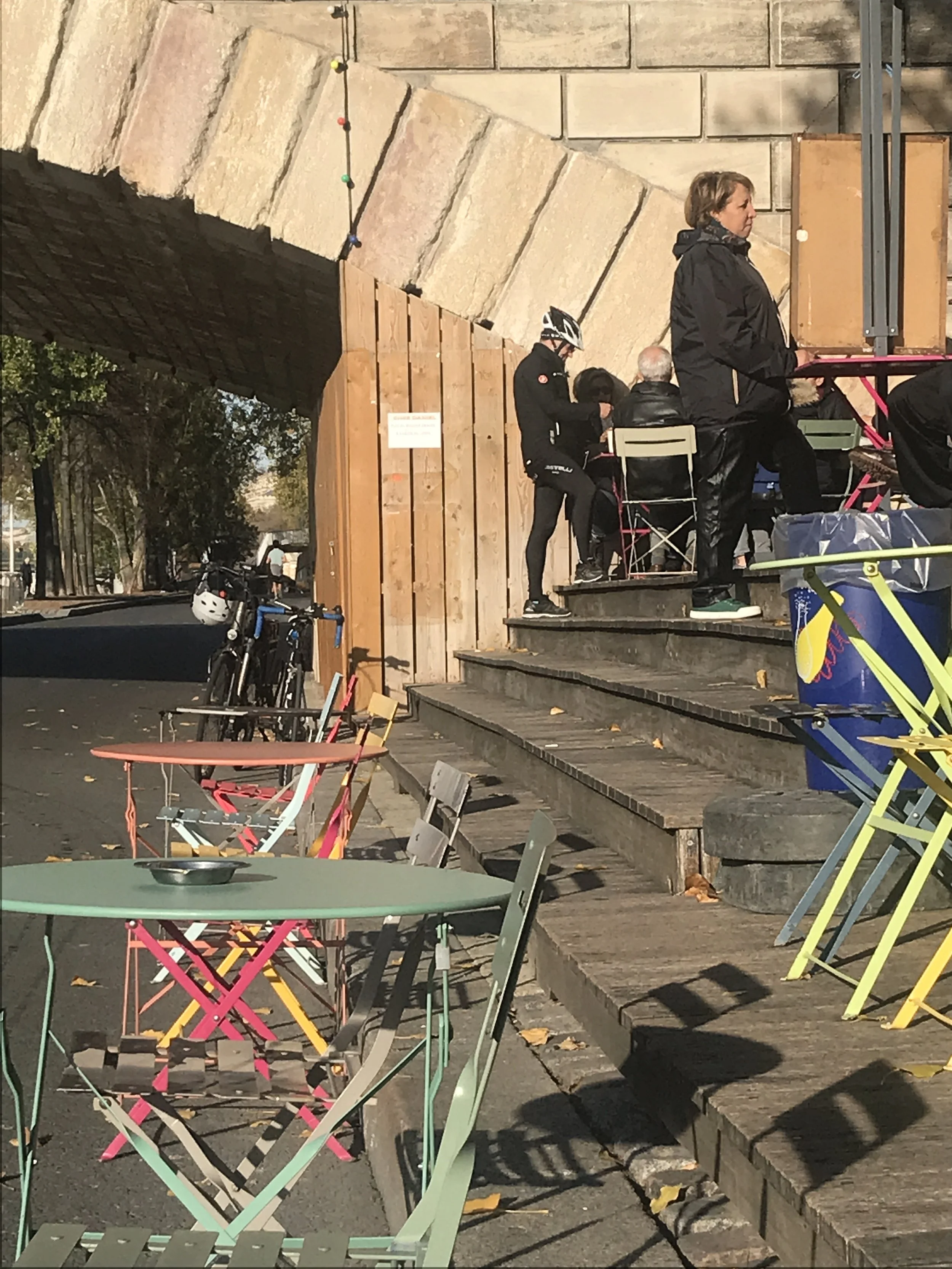The first time I saw Nadia, she was wearing green Chucks and a scowl. I ordered a jus de fruit mangue and settled for strawberry. She was out of mango. I handed her two coins totaling three euros because I didn’t have 2,50€ in exact change. Looking me straight in the eye and without any expression, she handed me a small bottle of fruit juice, a cup, and no change. Okay, I thought, so that’s how this works.
Nadia’s tiny outdoor place—I can hardly call it a café—became a stop on my daily morning walk and I became a regular. And though the two—Nadia and my walk—became intertwined, that’s not how this story begins. It begins with walking.
I have always walked in Paris, that goes without saying. I’m always searching out new things, uncovering new secrets, designing new itineraries, or simply going someplace. Over the years, I have traversed enough ground that the minutest details as well as the big picture are familiar. But last November, when almost every day was sunny and a few degrees one side or another of 60º, walking became an unconscious and then a conscious leitmotif. Two hours, three or four miles; every morning, give or take.
To paraphrase Julius Caesar, “Lutetia est omnis divisa in partes tres,” Paris is divided into three parts. There is everything on the street level: cars and buses and trottinettes; bouquinistes and cafés and people; arrow-straight boulevards with Haussmannian buildings and crooked streets with crooked medieval dwellings; Sacré-Cœur, Notre-Dame, the Eiffel Tower. Spelunkers explore, legally and illegally, the lowest level, a Swiss cheese array of quarry tunnels left after centuries of excavating limestone to build Paris; while the curious are drawn to an ossuary created from the remains of nearly seven million Parisians moved surreptitiously from overcrowded cemeteries in the eighteenth century. I walked the middle level, along the Seine. Here the city’s sounds melted away and only the occasional ringing of a bicycle bell punctuated the morning air.
I walked and I walked and I walked until I knew every cobblestone by heart, varying the distance, going farther and farther. From a quiet starting point in the Marais, I’d sometimes turn east before backtracking and heading west, sometimes going as far as Pont Neuf where it grew crowded and noisy, before turning back. Some days, inspired by other sportifs, I mustered the courage to work out, ignoring the passersby on land and water.
A cornucopia of life greeted me each morning. Passing through Place des Vosges on my way to the Seine, I noticed a dark-haired woman in a navy overcoat, gray wool cap, and Nike shoes trimmed with an aqua swoosh who swooshed herself, shifting left and right with marked deliberation, swinging her arms in an exaggerated motion. The next time I saw her, she was bare-headed, had on a puffer coat, yellow trimmed Nikes, and was still swaying. I decided that a man holding a sheaf of papers, walking back and forth in deep concentration, lips moving, was perhaps an actor memorizing lines. A woman running laps around Place des Vosges showed up by the river twenty minutes later, walking her dog. In the grass along the wall opposite the riverbank, I saw homeless people waking up and chatting outside their tents. Members of the Garde Républicaine clopped by on horseback, police drove by in small golf cart-like vehicles emblazoned with the seal of the City of Paris. Several times I stared as firefighters in wet suits jumped into the Seine—for fitness, bridge maintenance, fun, I never figured it out.
One morning a raucous crew of firefighters stopped to dry off and have a coffee at Nadia’s. They sat at tables next to her portable counter, greeted her enthusiastically, shouted her name. Which was how I, taking it all in at a nearby table, learned it. The next day, I stopped for a juice. “Bonjour, Nadia,” I said, in that matter-of-fact Parisian way. She didn’t register surprise. Instead, she said bonjour back, handed me a mango juice, and change, which I dropped in the tip cup. I began stopping every day, always addressing her by name, adding a sentence or two to make conversation. “How are you?” “It’s beautiful today.” “Yesterday you weren’t here, I thought you’d closed for the season.” By then, she’d softened. “No, she said, “if it’s raining or threatening, I don’t bother opening.”
Late in the afternoon on my last day in Paris, my feet led me to the river. There was a 10k race to benefit the Marie Curie Institute. Hundreds of people lined the quai. It was like a party. I caught the fireworks at the starting posts as the race began. And then Paris was bathed in violet light, the fleeting, magical l’heure bleue.
I never expected to see Nadia, but there she was, tucking her stand in for the night until the next day, when I’d be on a plane. I stopped. “Bonsoir, Nadia.” She smiled in recognition and we talked for several minutes. I told her I was leaving for a while, she asked where I was from. When I turned to walk away, I couldn’t stop the tears.
I’ll be back in Paris next week. My first stop will be Nadia’s. Because when I said goodbye, I think I forgot to tell her my name.


